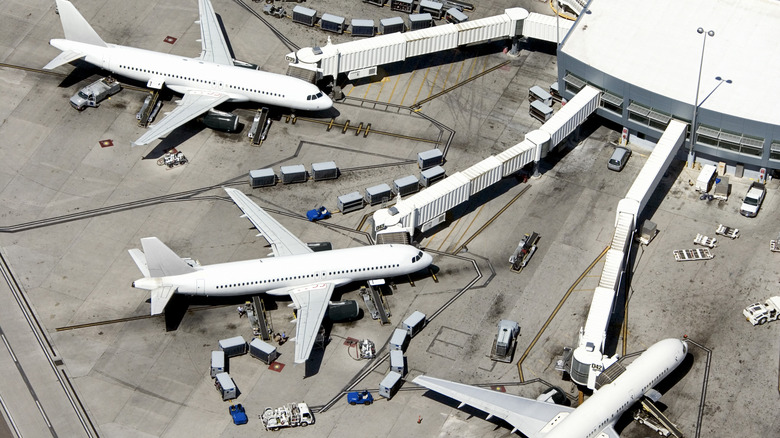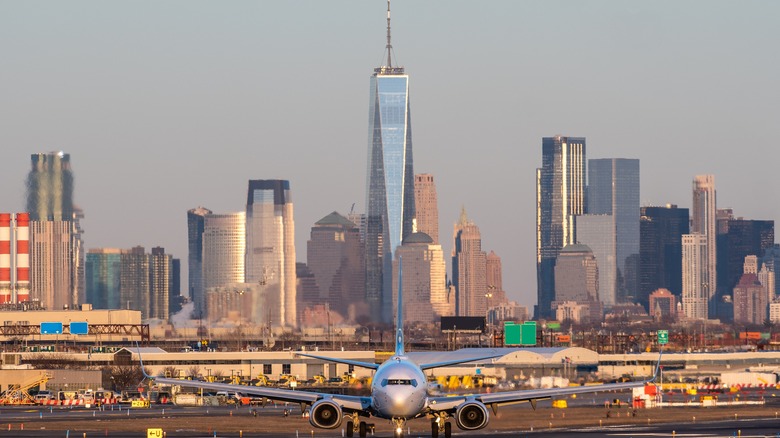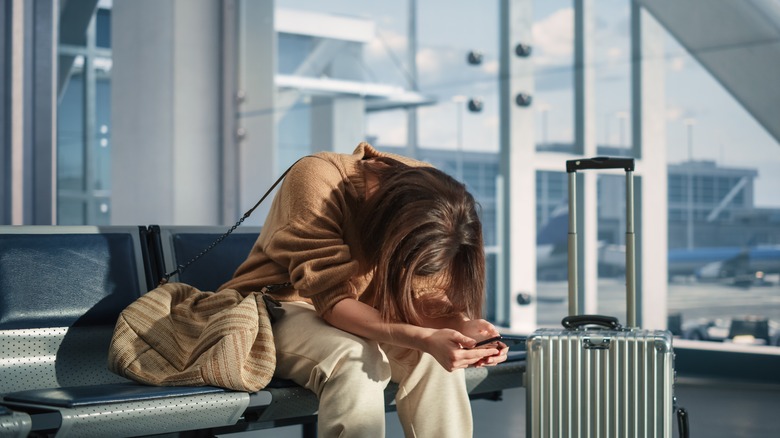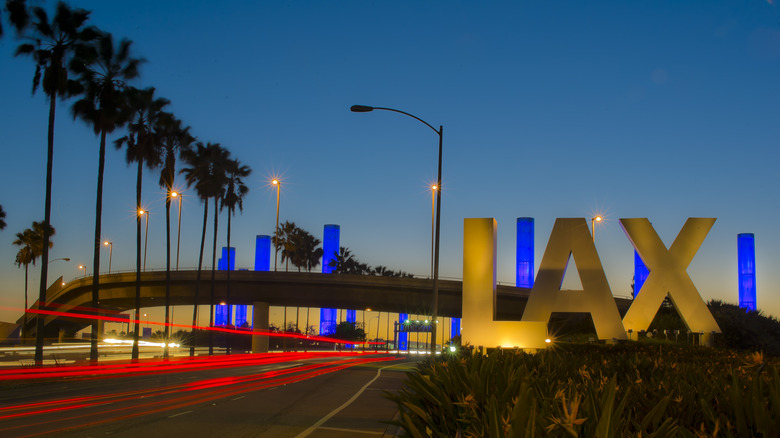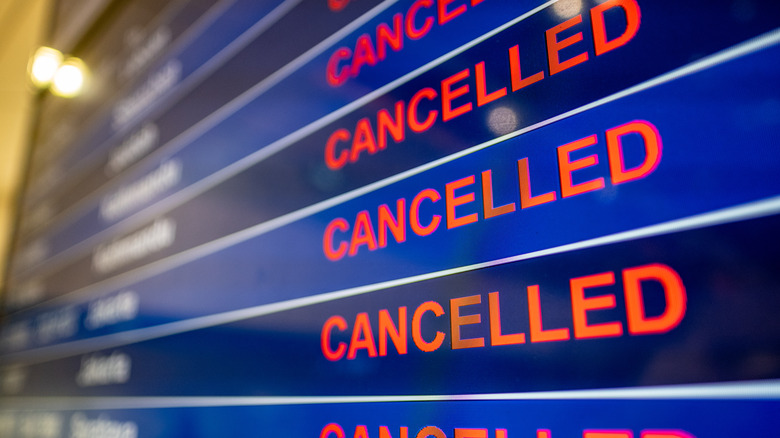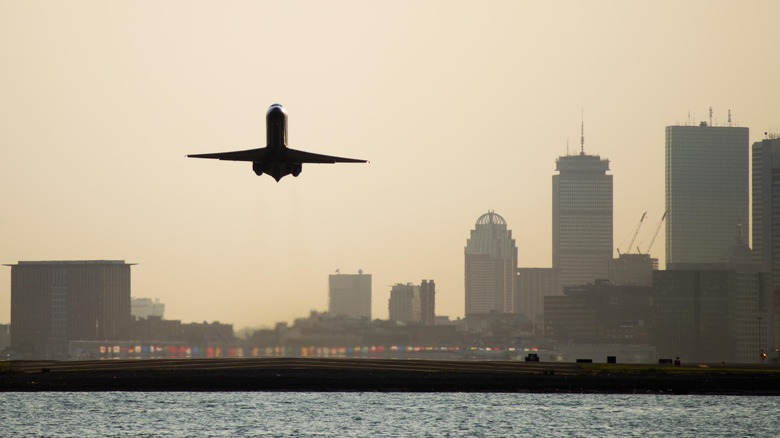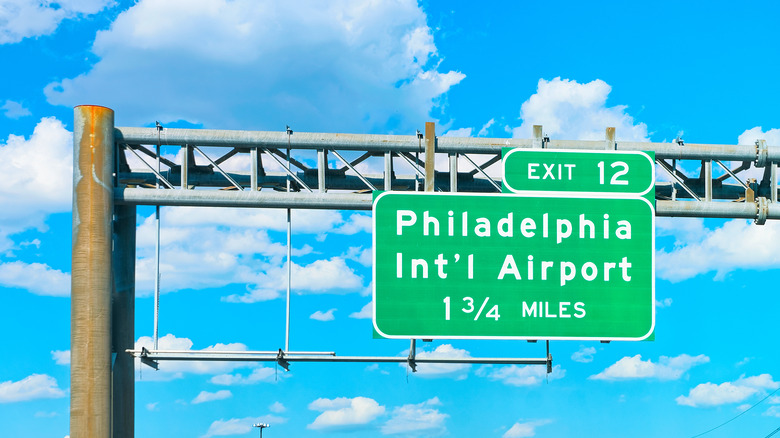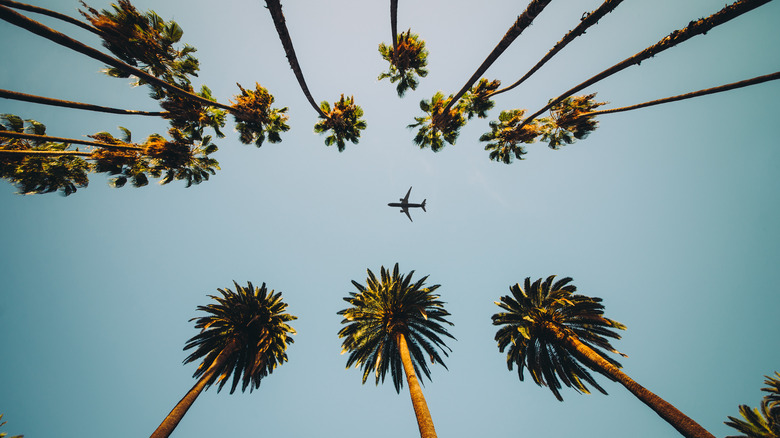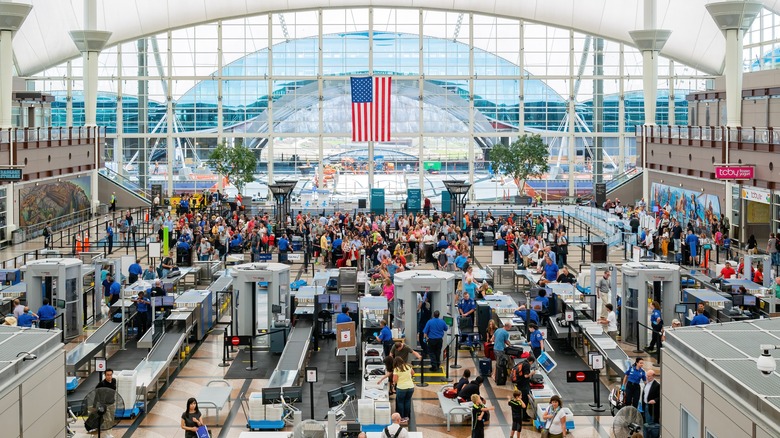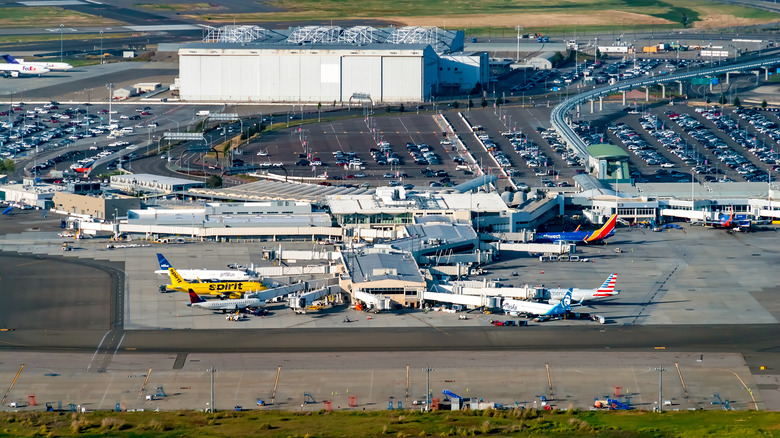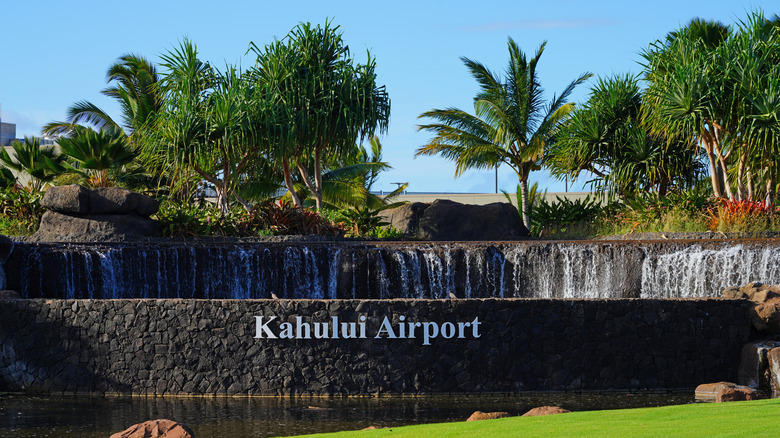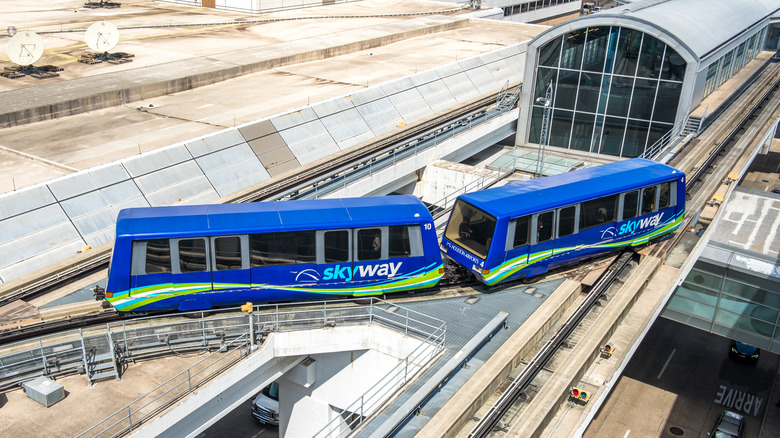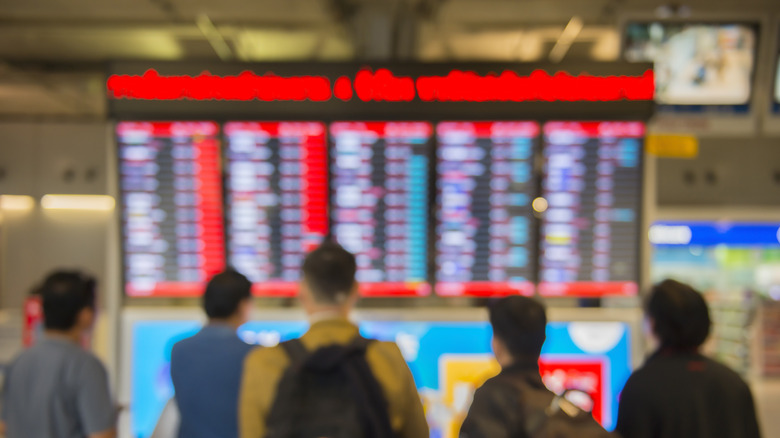Popular US Airports That Are Total Nightmares To Fly In And Out Of
There are few feelings more thrilling than the excitement of leaving for a trip. Packing your bags and jetting off — whether that be to somewhere exotic and new, or returning to somewhere familiar and cozy — is a freeing and refreshing sensation. But oftentimes, that initial fluttery feeling can quickly result in chaos when dealing with the dread of a disorderly airport. The obligatory process of the airport is a feat that any globetrotter knows all too well; and not only is it stressful and inconvenient, but it's usually also inevitable.
Traveling can be a joyous experience, but for many, the ordeal begins at the airport. While some airports excel in providing a seamless and enjoyable journey, others fall short, leading to frustration and stress for passengers. While waiting in lines and going through TSA may be unavoidable for air travel, some airports have been reported to be more arduous than others. We'll unveil the top contenders for the worst U.S. airports to fly in and out of, exploring the reasons behind their dismal reputations.
Newark Liberty International Airport (EWR) – New Jersey
This New Jersey airport is a very popular hub for travelers visiting New York City, as it is just 15 miles from the Big Apple. That being said, it is widely regarded as an overall unsatisfactory airport by millions of passengers. In the consumer analytics company J.D. Power's annual North American Airport Satisfaction Study for 2023, Newark ranked dead last, receiving a satisfaction rate of 732 out of 1,000, considerably lower than other contenders.
Year-round, but particularly during the busy summer months, Newark sees an exorbitant amount of delays and cancellations. The Wall Street Journal created its own study for the worst U.S. airports in terms of performance, and EWR held the bottom spot. WSJ evaluated several different criteria, including on-time arrivals and departures, security wait times, and concession prices.
High passenger volume, understaffing, adverse weather conditions, and the overcrowding of the NY-area airspace are all contributing factors to the airport's problems. Newark is a notably busy airport, mostly because of its proximity to one of the most booming economic, financial, and multicultural cities in the world: New York City, which also contains some of the world's most iconic sites, so it's no surprise why millions of people travel to the city each year. If you're visiting NYC soon and you'd like to bypass this nightmare of an airport, you may consider JFK or LaGuardia instead.
Chicago O'Hare International Airport (ORD) – Illinois
Chicago O'Hare International is yet another airport seen by many as a tumultuous ordeal of an airport. It's rated as the fourth busiest airport in the US and the sixth busiest airport in the world. The airport is simply massive, spanning 7660 acres in the northwest metropolitan area of Chicago. Many are overwhelmed by its size, and the recent $6 billion remodel, which many anticipated would create all-around improvements, has still resulted in never-ending lines and travelers in agony.
Despite being one of the busiest airports in the world, another main reason for ORD being a traveler's nightmare is because Chicago is a winter-weather city. This means delays and cancellations galore. Crowded runways, taxiing for long periods, and air traffic control getting backed up are to blame for a majority of Chicago O'Hare's arrival and departure problems.
However, there are some pretty neat facilities travelers may utilize to escape the hustle and bustle of ORD. For a moment of tranquility, you can unwind in the airport's yoga room, which offers eco-friendly bamboo flooring, yoga mats at your disposal, and a TV with yoga tutorials. There are also several art installations, such as a four-story-high brachiosaurus in Terminal 1 and the world flags hanging in Terminal 3. While these amenities may help a long layover, don't let it fool you, because this Chicago airport received low marks on the J.D. Power study, with passengers citing long security lines and delays (sometimes over two hours!) getting through customs.
Los Angeles International Airport (LAX) – California
Los Angeles International Airport (LAX) is often considered a challenging airport to navigate for several reasons. One of the primary concerns is the notorious traffic congestion in and around the airport, causing delays for both arrivals and departures. LAX is located in a densely populated urban area, exacerbating the issue of vehicular gridlock. The complex layout of terminals can be confusing for passengers, leading to extended walking distances and potential difficulties in finding gates.
Additionally, LAX has faced criticism for aging infrastructure and outdated facilities, contributing to a less-than-ideal travel experience. In an interview with the Los Angeles Times, Cheryl Marcell, a spokeswoman for ACI World (an airport trade group), said, "LAX, whose terminal complex was originally built in 1961, is at a disadvantage when compared to newer, privately funded airports in Asia and the Middle East."
Furthermore, LAX is notorious for its susceptibility to weather-related disruptions, particularly the city's infamous coastal fog. This climatic factor often leads to flight delays and cancellations, further compounding the challenges travelers face. Additionally, the airport's limited public transportation options make it heavily reliant on vehicular traffic, exacerbating the traffic congestion issue. With the sprawling nature of Los Angeles and its surrounding areas, getting to and from LAX can be a time-consuming and frustrating experience.
Hartsfield-Jackson Atlanta International Airport (ATL) – Georgia
Hartsfield-Jackson Atlanta International Airport (ATL), while being one of the busiest airports in the world, has earned a reputation as a difficult hub to fly in and out of. One major concern is the sheer size of the airport, with multiple terminals and concourses spread across a vast area. Navigating this expansive layout can be time-consuming, and passengers often find themselves facing long walks or relying on the airport's transportation system. Additionally, the airport's immense passenger traffic can result in crowded terminals, exacerbating the issue of finding seating, accessing amenities, and moving efficiently through security checkpoints.
Another notable issue at ATL is its vulnerability to weather-related disruptions. Atlanta experiences occasional severe weather events, including thunderstorms and hurricanes, which can lead to flight delays and cancellations. The airport's susceptibility to these weather patterns can significantly impact the reliability of flight schedules, causing frustration for travelers trying to navigate through Hartsfield-Jackson. Despite ongoing efforts to improve and expand the airport's facilities, its sheer size, passenger volume, and vulnerability to weather-related challenges contribute to the perception that navigating Atlanta Airport can be an overwhelming and sometimes nightmarish experience.
Logan International Airport (BOS) – Massachusetts
Logan International Airport (BOS) in Boston has garnered notoriety for being a troublesome airport to navigate for various reasons. One significant issue is the airport's layout and limited space, which can lead to congestion and delays, particularly during peak travel times. The terminals are often criticized for being cramped, and the overall design can create bottlenecks at security checkpoints and in boarding areas. Passengers have reported problems in finding available seating, and the limited number of amenities contributes to a less-than-pleasant travel experience.
Boston's unpredictable weather also adds to the difficulties of flying in and out of Logan Airport. The city experiences harsh winter conditions, including snowstorms, which can result in flight cancellations and delays. The airport's proximity to the Atlantic Ocean makes it susceptible to coastal weather patterns that can disrupt air travel plans. Furthermore, road traffic around the airport can be congested, impacting ground transportation and making it difficult for passengers to reach the airport or exit efficiently.
Philadelphia International Airport (PHL) – Pennsylvania
Philadelphia International Airport (PHL) has faced criticism and is seen as a tough airport to fly in and out of for various reasons. One significant issue is the airport's historical struggles with baggage handling and overall operational efficiency. Passengers have reported delays and disruptions in baggage claim, contributing to frustrations and inconvenience. The airport's terminals have also been criticized for their dated infrastructure, leading to challenges in accommodating the growing number of passengers. Insufficient amenities and limited dining and shopping options further contribute to the perception that PHL falls short of providing a positive and seamless travel experience.
In addition to these infrastructure challenges, Philadelphia Airport has encountered issues with on-time performance. Delays are not uncommon, and travelers have expressed dissatisfaction with the overall reliability of flight schedules. Transportation to and from the airport has also been a point of contention, with some passengers facing difficulties accessing efficient and convenient options. While there have been ongoing efforts to address some of these issues, including terminal renovations, the combination of historical problems with baggage handling, infrastructure limitations, and on-time performance challenges has contributed to the perception that Philadelphia International Airport can be a challenging and at times nightmarish airport for air travel.
Miami International Airport (MIA) – Florida
Miami International Airport (MIA) is often described as a formidable airport for travelers, facing several issues that contribute to a less-than-ideal flying experience. One significant concern is the long security lines and immigration waits. MIA, being a major gateway for international flights, can experience extensive lines during peak travel times, leading to frustrating delays for passengers. The extensive wait times at security checkpoints and immigration counters have been a common source of dissatisfaction among travelers, contributing to the airport's reputation as a challenging destination for air travel.
Reports of cleanliness and hygiene issues at Miami Airport have also added to the airport's negative perception. Some passengers have expressed dissatisfaction with the maintenance and cleanliness standards in certain areas of the airport, affecting the overall passenger experience. Crowded terminals further compound these concerns, making it frustrating for travelers to find comfortable seating or enjoy a clean and pleasant environment while waiting for their flights.
Additionally, Miami International Airport has faced struggles with ground transportation and traffic congestion in the surrounding areas. The limited public transportation options and the reliance on vehicular traffic contribute to difficulties in reaching and leaving the airport efficiently. As one of the busiest airports in the United States, the heavy traffic conditions around MIA can lead to stressful travel experiences, particularly during peak hours.
Denver International Airport (DEN) – Colorado
Denver International Airport (DEN) has faced difficulties that contribute to its reputation as a rather frustrating airport for travelers. One notable concern is the airport's susceptibility to weather-related disruptions, particularly during winter months. Denver experiences heavy snowfall, leading to flight delays and cancellations that can significantly impact the reliability of travel plans. The region's unpredictable weather patterns can create a domino effect, causing a backlog of delayed flights and frustrating experiences for passengers trying to navigate through DEN. Despite efforts to mitigate these weather-related challenges, the airport's vulnerability to adverse conditions continues to contribute to the perception that it can be a nightmare to fly in and out of Denver.
Another source of frustration for passengers at Denver International Airport is the complex layout and lengthy distances within the terminals. The expansive design of the airport, combined with the vast distances between gates and baggage claim areas, can result in long walks and increased travel times for passengers. Navigating through the airport can be particularly challenging for those with tight connections or limited mobility. While the airport's unique architecture and design have been a point of interest to some, the layout can create a cumbersome and confusing experience for others.
Oakland International Airport (OAK) – California
Travelers may find Oakland International Airport (OAK) to be less than ideal due to a number of issues that the airport has had to deal with. One significant concern is the limited flight options, especially for international travel. OAK primarily serves as a domestic airport, offering fewer international flights compared to other major airports in the region. This limitation can force travelers to use alternative airports for international journeys, adding complexity and inconvenience to their overall travel plans.
Transportation to and from Oakland Airport has also been a consistent source of dissatisfaction for travelers. Traffic congestion in the vicinity of the airport further compounds these issues, creating difficulties for passengers navigating through crowded roadways to catch their flights. Additionally, Oakland International Airport has faced challenges related to outdated facilities and limited amenities. On Skytrax, an airline and airport review website, travelers report inadequate dining options and insufficient services within the terminals. While efforts may be underway to address these issues, the overall passenger experience at OAK can be impacted by the perceived shortcomings in amenities and facilities.
Kahului Airport (OGG) – Hawaii
Kahului Airport (OGG) in Maui, Hawaii, has faced obstacles that have led to it being known as an arduous airport for travelers. One of the primary concerns is the limited capacity of the airport to handle the increasing number of visitors to the island. Maui's popularity as a tourist destination has resulted in congestion and overcrowding at Kahului Airport, particularly during peak travel seasons. The airport's facilities, designed to accommodate a smaller volume of passengers, can become overwhelmed, leading to long lines at check-in counters, security checkpoints, and baggage claim areas. This overcrowding has been a consistent source of frustration for travelers.
Transportation options to and from Kahului Airport also pose challenges for travelers. While rental cars are a common choice, the limited availability and high demand can result in delays and increased costs. Public transportation options are relatively limited, and traffic congestion around the airport can further impede efficient travel. As the gateway to Maui, addressing these capacity and transportation issues is crucial for improving the overall travel experience at Kahului Airport and ensuring a smoother journey for visitors to the island.
George Bush Intercontinental Airport (IAH) – Texas
George Bush Intercontinental Airport (IAH) in Houston, Texas, has encountered various dilemmas that contribute to its standing as a nightmarish airport for travelers. One notable issue is the airport's extensive layout and complex terminal structure. The sheer size of IAH, with multiple terminals and concourses, often leads to confusion and longer travel times for passengers trying to navigate through the airport. The distances between gates and facilities can be considerable, resulting in lengthy walks that can be particularly problematic for passengers with tight connections or those with limited mobility. The expansive layout has been a consistent source of frustration for travelers, contributing to the perception that George Bush Airport can be a labyrinthine nightmare to navigate.
Houston's weather patterns add another layer of complexity to flying in and out of George Bush Airport. The region is prone to thunderstorms, hurricanes, and other severe weather events that can disrupt flight schedules, leading to delays and cancellations. The unpredictability of weather conditions in Houston poses challenges for both arriving and departing flights, impacting the overall reliability of air travel through IAH. Travelers are often advised to check for weather-related updates and anticipate potential disruptions when planning their journeys to or from George Bush Intercontinental Airport.
In addition to these logistical struggles, George Bush Airport has faced criticism for its limited public transportation options. While efforts have been made to enhance connectivity, the reliance on private vehicles remains high. This can lead to traffic congestion around the airport, making it difficult for passengers to reach their terminals efficiently.
Orlando International Airport (MCO) – Florida
In Orlando, Florida, home of Walt Disney World Resort and Magic Kingdom, lies Orlando International Airport just 17 miles away. It's quite a juxtaposition from "The Most Magical Place On Earth" to the mayhem of misery of MCO airport. Orlando is one of the most visited cities in the United States because of the millions of travelers from around the globe here to visit the area's world-famous theme parks.
With such a high volume of travelers, Orlando International Airport can be a mess of an airport. Unlike many airports in the U.S., which normally advise you to arrive 90 minutes before boarding, MCO advises passengers to arrive three hours prior to their flight, whether flying international or domestic. The reasoning for this is simple. Many people flying into and out of MCO aren't your average businessperson who travels for work. Instead, these infrequent flyers may be on a once-in-a-lifetime trip to Disney, thus they may be unfamiliar with TSA rules for properly packing liquids, slow to find their IDs, and even slower to react to screening directives.
Nearly 50 million travelers passed through MCO in 2022 alone, and the elongated security queues aren't the only stressors at MCO. Orlando airport is understaffed, has consistently late flights and delays, and is unnecessarily large (11,600 acres) yet still insanely congested. While a visit to the Magic Kingdom may be fun, the lengthy lines at MCO are not.
